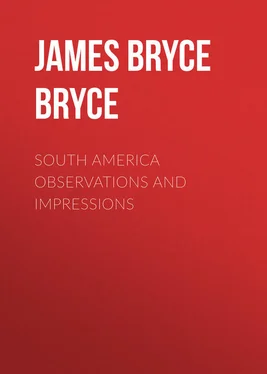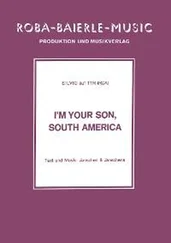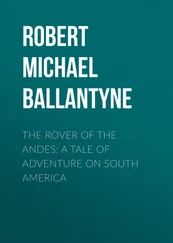James Bryce Bryce - South America Observations and Impressions
Здесь есть возможность читать онлайн «James Bryce Bryce - South America Observations and Impressions» — ознакомительный отрывок электронной книги совершенно бесплатно, а после прочтения отрывка купить полную версию. В некоторых случаях можно слушать аудио, скачать через торрент в формате fb2 и присутствует краткое содержание. Жанр: foreign_antique, foreign_prose, на английском языке. Описание произведения, (предисловие) а так же отзывы посетителей доступны на портале библиотеки ЛибКат.
- Название:South America Observations and Impressions
- Автор:
- Жанр:
- Год:неизвестен
- ISBN:нет данных
- Рейтинг книги:3 / 5. Голосов: 1
-
Избранное:Добавить в избранное
- Отзывы:
-
Ваша оценка:
- 60
- 1
- 2
- 3
- 4
- 5
South America Observations and Impressions: краткое содержание, описание и аннотация
Предлагаем к чтению аннотацию, описание, краткое содержание или предисловие (зависит от того, что написал сам автор книги «South America Observations and Impressions»). Если вы не нашли необходимую информацию о книге — напишите в комментариях, мы постараемся отыскать её.
South America Observations and Impressions — читать онлайн ознакомительный отрывок
Ниже представлен текст книги, разбитый по страницам. Система сохранения места последней прочитанной страницы, позволяет с удобством читать онлайн бесплатно книгу «South America Observations and Impressions», без необходимости каждый раз заново искать на чём Вы остановились. Поставьте закладку, и сможете в любой момент перейти на страницу, на которой закончили чтение.
Интервал:
Закладка:
South America Observations and Impressions New edition corrected and revised
PREFACE
This book records observations made and impressions formed during a journey through western and southern South America from Panama to Argentina and Brazil via the Straits of Magellan. The nature of its contents is briefly outlined in the Introduction which follows, so all that I have to do here is to acknowledge gratefully the many kindnesses I received in every part of South America which I visited, and in particular from the following persons: Colonel Goethals, Chief Engineer of the Panama Canal, and other officers of the United States engineers stationed there, and Colonel Gorgas, head of the medical staff; the officials of the Peruvian Corporation in Lima and of the Peruvian Southern Railways in Mollendo, Arequipa, and La Paz; the officials of the Antofagasta and Bolivia Railroad Company; those of the Transandine Railway Company in Chile and those of the Buenos Aires and Pacific and Argentine Great Western Railways Companies in Mendoza and Buenos Aires, and also those of the Leopoldina Railway in Brazil. Nor must I fail to express my obligations to the heads in New York of the firm of Messrs. W. R. Grace Co., who advised me regarding my journey, and to my friend Professor Bingham of Yale University, who, familiar with South America from his own travels and studies, has given me valuable help in many ways.
I have also to return my respectful thanks to the Governments of Chile and Brazil, who were good enough to extend to me facilities for travel on their railways, and to the Governments of Peru, Bolivia, Argentina, and Uruguay for other courtesies. To many statesmen and scholars in these six republics, too numerous to mention by name, as also to not a few of my own fellow-countrymen from Britain and Canada who are there settled, I am indebted for hospitality, for private acts of kindness, and for valuable information.
JAMES BRYCE.June 27, 1912.
INTRODUCTION
Whoever read as a boy the books of old travellers in the Andes, such as Humboldt's Aspects of Nature , or pored over such accounts of the primitive American peoples as are given in Prescott's Conquest of Peru must have longed to visit some day the countries that fired his imagination. These had been my experiences, and to them there was subsequently added a curiosity to learn the causes which produced so many revolutions and civil wars in Spanish America, and, still later, a sense that these countries, some of them issuing from a long period of turbulence, were becoming potent economic factors in the modern world. So when after many years the opportunity of having four clear months for a journey to South America presented itself, I spent those months in seeing as much as I could within the time, and was able to make some observations and form certain impressions regarding the seven republics I visited. These observations and impressions are contained in the following pages. They are, of course, merely first impressions, but the impressions which travel makes on a fresh mind have their value if they are tested by subsequent study and by being submitted to persons who know the country thoroughly. I have tried so to test these impressions of mine, and hope they may be of service to those who desire to learn something about South America, but have not time to peruse the many books of travel that have been written about each of its countries.
The chief points of interest which these countries have for Europeans and North Americans may be summed up as follows: —
1. The aspects of nature.
2. The inhabitants, the white part of whom are of Spanish origin, except the Brazilians, who come from Portugal.
3. The economic resources of the several countries.
4. The prospects for the development of industry and commerce.
5. The relics of prehistoric civilization.
6. The native Indian population.
7. The conditions of political life in the several republics.
It may be convenient that I should explain how far and in what order each of these topics is dealt with.
The first eleven chapters of the book contain a description of what I saw of scenery and of social and economic phenomena in the seven republics of Panama, Peru, Bolivia, Chile, Argentina, Uruguay, and Brazil, and in these chapters the first three of the above-mentioned subjects are dealt with when and as each country is described. It is Nature that chiefly engages the traveller's mind in Peru and Bolivia, as it is economic development which interests him in Argentina and Uruguay. In Chile and Brazil he must be always thinking of both. The fourth topic has been treated so fully by many writers who have brought special knowledge to it and have written professedly for the information of business men, that I have not thought it necessary to fill this book with statistical tables or, indeed, to do more than indicate the possibilities for commercial development or agricultural immigration which the natural resources of each country seem to promise.
It is only in Peru and Bolivia that any prehistoric monuments exist. Some of the most important and interesting of these I saw, and in describing them I have endeavoured to convey an idea of the character of the ancient Peruvian civilization (if that name can properly be applied to it) and of the people who produced it. This is done in Chapters III, IV, and V.
Only in Peru, Bolivia, and Chile did I have opportunities of seeing the native Indians. In the two former states they constitute a part of the total population far larger than in any other state (except Paraguay): they are nominally Christians, and they lead a settled agricultural life. In Chile there is only one considerable Indian tribe remaining, the famous Araucanians. Of these warriors, of the Quichuas in Peru and of the Aymarás in Bolivia, some account will be found in Chapters IIIto VI.
In the above-mentioned eleven descriptive chapters I have endeavoured to individualize, so to speak, the chief countries of South America, so as to bring out the chief characteristics, natural and human, of each of them.
But marked as are the differences between the various republics, they have all something in common, something that belongs to South America as opposed to Europe or North America or Australia. There are also certain general questions affecting the whole Continent which present themselves to the traveller's mind and need to be discussed upon broad and general lines. To these questions the last five chapters of the book have been devoted. One chapter endeavours to indicate the causes which have divided the vast Spanish-American dominion (including Mexico and Central America) as it stood in A.D. 1810 into the sixteen independent republics of to-day, some of which have become, others of which are becoming, true nations with marked national characteristics. Another chapter deals with the relations to the white population of the aborigines in the Spanish countries and of the negroes in Brazil, the only state in which negroes are numerous. It is a subject of study all the more interesting because these relations are altogether different from those borne by the European element to the coloured races in the British colonies, in India, and in the United States of North America, and also because the intermixture of races which is now going on in South America suggests physiological and ethnological problems of high interest.
A third chapter ( Chapter XIV) briefly compares the conditions of settlement and of government which determined the course of economic and political development in North and in South America respectively and enquires how far the latter Continent is to be considered any more closely related to the former than it is to Europe. Is there, in fact, such a thing as that which the word Pan-Americanism is intended to describe, or does the expression denote an aspiration rather than a fact?
Читать дальшеИнтервал:
Закладка:
Похожие книги на «South America Observations and Impressions»
Представляем Вашему вниманию похожие книги на «South America Observations and Impressions» списком для выбора. Мы отобрали схожую по названию и смыслу литературу в надежде предоставить читателям больше вариантов отыскать новые, интересные, ещё непрочитанные произведения.
Обсуждение, отзывы о книге «South America Observations and Impressions» и просто собственные мнения читателей. Оставьте ваши комментарии, напишите, что Вы думаете о произведении, его смысле или главных героях. Укажите что конкретно понравилось, а что нет, и почему Вы так считаете.












